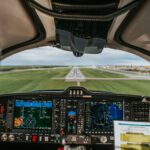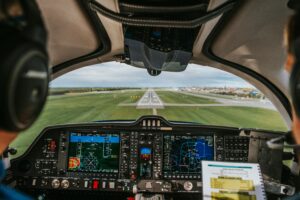Passenger airplanes soar to great heights, defying gravity and captivating our imaginations. But have you ever wondered why planes fly so high up in the sky? The answer lies in the quest for speed and fuel efficiency. By cruising at high altitudes, aircraft can harness the benefits of lower air pressure and fewer gas molecules, resulting in reduced drag and improved performance. Additionally, the thinner air allows planes to burn less fuel while maintaining higher speeds, making it an ideal strategy for long-haul flights. In this article, we will explore the science behind why planes fly at such lofty heights and the advantages it brings to the world of aviation.
Key Takeaways
- Passenger airplanes fly at high altitudes to increase speed, fuel efficiency, and take advantage of less dense air.
- Altitude refers to the height of an object or point in relation to sea level or ground level, and higher altitudes have lower air pressure and fewer gas molecules.
- Aircraft are pressurized to compensate for the lack of air pressure at high altitudes and ensure the safety and comfort of passengers.
The Importance of High Altitudes for Airplanes
Understanding Altitudes and Air Pressure
Altitude plays a crucial role in the world of aviation. It refers to the height of an object or point in relation to sea level or ground level. As altitude increases, air pressure decreases, and there are fewer gas molecules in the air. This decrease in air pressure at higher altitudes has significant implications for airplanes.
Pressurization of Aircrafts
To compensate for the lack of air pressure at high altitudes, aircraft are equipped with pressurization systems. Pressurization ensures a comfortable and safe environment for passengers and crew members on board. Without this system, the low air pressure at high altitudes could lead to various health issues, such as hypoxia, a condition caused by insufficient oxygen supply to the body.
To further ensure the well-being of passengers, modern airplanes are equipped with oxygen masks that are ready to be deployed in case of an emergency. These masks use a chemical reaction to release oxygen, providing a vital lifeline in situations where the cabin pressure drops significantly.
Advantages of Higher Altitudes for Planes
Passenger airplanes are designed to fly at high altitudes for several reasons, including increased speed and fuel efficiency. High altitudes offer less dense air, allowing planes to burn less fuel and achieve higher speeds. Jet engines, in particular, are most efficient at high altitudes, maximizing the power-to-fuel consumption ratio.
Moreover, higher altitudes result in less friction or drag on the plane. This reduced drag allows airplanes to maintain their speed with less effort, resulting in improved fuel efficiency. The Concorde, a famous supersonic jet, took advantage of even higher altitudes to benefit from thinner air and reduced drag, enabling it to reach incredible speeds.
Commercial airplanes typically have specific cruising altitudes, usually between 30,000 and 36,000 feet. Flying at these altitudes provides several advantages. Firstly, it offers protection from bad weather conditions, including turbulence, thunderstorms, and icing, which are more prevalent at lower altitudes. Additionally, the thinner air at high altitudes reduces air resistance, allowing planes to operate more efficiently and perform better.
It’s important to note that commercial airplanes have a certified maximum altitude of around 40,000 to 45,000 feet. Flying too high can lead to mechanical failure, engine suffocation due to lack of oxygen, and insufficient lift from the wings. Therefore, pilots carefully adhere to the specified altitude limits to ensure the safety and well-being of everyone on board.
In conclusion, flying at high altitudes is vital for airplanes to achieve optimal speed, fuel efficiency, and performance. Altitude affects air pressure, and aircraft are equipped with pressurization systems to compensate for the lower pressure at higher altitudes. The advantages of flying at higher altitudes include reduced air resistance, improved fuel efficiency, and protection from adverse weather conditions. However, it’s crucial to operate within the certified altitude limits to avoid potential risks and ensure a safe journey for all passengers and crew members.
Increased Speed and Fuel Efficiency
Impact of Altitude on Speed and Efficiency
When you look up at the sky and see a plane soaring high above, you may wonder, “Why do planes fly so high?” The answer lies in the pursuit of increased speed and fuel efficiency. Altitude, which refers to the height of an object or point in relation to sea level or ground level, plays a crucial role in achieving these goals.
At higher altitudes, air pressure decreases, and there are fewer gas molecules present in the atmosphere. This lower air pressure creates a less dense air environment for airplanes. To combat the lack of air pressure at high altitudes, aircraft are pressurized. This pressurization ensures that passengers can breathe comfortably and prevents any adverse effects of low oxygen levels.
But how does flying at high altitudes contribute to increased speed and fuel efficiency? The answer lies in the concept of less dense air. With fewer gas molecules in the atmosphere, planes experience less air resistance, or drag, as they slice through the sky. This reduction in drag allows aircraft to burn less fuel and fly faster compared to lower altitudes.
Role of Less Dense Air in Faster Flying
The advantages of flying at higher altitudes become even more apparent when we consider jet engines. These powerful engines, commonly used in commercial airplanes, are designed to operate most efficiently at high altitudes.
Jet engines rely on the principle of combustion to generate thrust and propel the aircraft forward. At higher altitudes, where the air is less dense, the combustion process becomes more efficient. The reduced air density allows the jet engines to take in more air and mix it with fuel, resulting in a more effective and powerful combustion.
The improved efficiency of jet engines at high altitudes translates into increased speed and reduced fuel consumption. As planes fly higher, they can maintain higher cruising speeds while consuming less fuel per unit of distance traveled. This combination of speed and fuel efficiency is a win-win for both airlines and passengers.
Jet Engines’ Efficiency at High Altitudes
To further illustrate the impact of altitude on speed and efficiency, let’s take a look at the Concorde, a legendary supersonic jet. The Concorde was known for flying at extremely high altitudes to take advantage of the thinner air and reduced drag.
By soaring at altitudes reaching up to 60,000 feet, the Concorde could achieve speeds of Mach 2, or twice the speed of sound. The reduced air density at such heights allowed the Concorde to overcome the limitations imposed by drag, enabling it to travel at unprecedented speeds.
While commercial airplanes typically operate at lower altitudes, usually between 30,000 and 36,000 feet, they still reap the benefits of higher altitudes. Flying at these altitudes provides protection from inclement weather and enhances fuel efficiency and performance due to the thinner air and reduced resistance.
It’s worth noting that commercial airplanes have a certified maximum altitude of around 40,000 to 45,000 feet. Beyond this point, flying too high can lead to mechanical failures, engine suffocation due to insufficient oxygen, and insufficient lift from the wings.
In conclusion, the decision to fly at high altitudes is driven by the desire to increase speed and fuel efficiency. The less dense air at higher altitudes reduces drag, allowing planes to burn less fuel and travel faster. Jet engines, in particular, thrive in this environment, operating at peak efficiency and propelling aircraft to new heights. So the next time you glance up at a plane soaring through the sky, remember that its lofty position is not just for show—it’s a strategic choice to maximize performance and economy.
Reduced Friction and Drag
Effects of High Altitudes on Friction and Drag
When it comes to air travel, reaching high altitudes is not just a matter of soaring into the sky; it’s a strategic move to enhance speed and fuel efficiency. Altitude, in the context of aviation, refers to the height of an aircraft in relation to sea level or ground level. As an aircraft ascends to higher altitudes, the air pressure decreases, and there are fewer gas molecules present in the atmosphere. This reduction in air pressure has a significant impact on the performance of an aircraft, particularly in terms of friction and drag.
The Concorde’s Example of Reduced Drag
The Concorde, a legendary supersonic jet, serves as an exemplary case of how high altitudes can lead to reduced drag. The Concorde was designed to fly at even higher altitudes than traditional commercial airplanes, taking full advantage of the thinner air found at these heights. By doing so, it minimized the resistance it encountered, enabling it to achieve astonishing speeds. The Concorde’s ability to reach altitudes where the air is less dense allowed it to push the boundaries of aviation and set new standards for efficiency.
Benefits of Less Resistance during Flight
Reduced friction and drag offered by higher altitudes bring numerous benefits to aircraft and their operators. Firstly, the less dense air at higher altitudes enables planes to burn less fuel. With fewer gas molecules impeding their progress, aircraft can propel forward more efficiently, requiring less energy to maintain their velocity. This fuel efficiency translates into significant cost savings for airlines and a greener approach to air travel.
In addition to fuel savings, flying at higher altitudes allows planes to reach higher speeds. Jet engines, which power most commercial airplanes, are designed to perform optimally at high altitudes. The reduced air resistance at these heights allows the engines to generate more thrust, propelling the aircraft forward with greater force. As a result, planes can achieve higher velocities, reducing travel times and increasing operational efficiency.
Furthermore, high altitudes provide protection against adverse weather conditions. By flying above cloud formations and turbulent air masses, pilots can navigate through smoother skies, ensuring a safer and more comfortable journey for passengers. Additionally, the thinner air at high altitudes minimizes the impact of atmospheric disturbances, further enhancing the stability and control of the aircraft.
It’s important to note that commercial airplanes have specific cruising altitudes, typically ranging from 30,000 to 36,000 feet. These altitudes strike a balance between the benefits of reduced air resistance and the need for pressurization and oxygen supply for passengers and crew. Most commercial aircraft are pressurized to compensate for the lower air pressure at high altitudes, ensuring a comfortable environment inside the cabin.
However, it’s worth mentioning that there is a limit to how high an aircraft can fly safely. Commercial airplanes have a certified maximum altitude, typically around 40,000 to 45,000 feet. Flying beyond this threshold can lead to various issues, including mechanical failure, engine suffocation due to lack of oxygen, and insufficient lift from the wings. Therefore, while high altitudes offer numerous advantages, pilots must carefully consider the optimal altitude for each flight, taking into account factors such as aircraft capabilities, weather conditions, and passenger comfort.
In conclusion, the decision to fly at high altitudes is not arbitrary; it is a strategic choice driven by the desire to maximize speed, fuel efficiency, and safety. By taking advantage of the reduced friction and drag offered by thinner air at high altitudes, aircraft can achieve faster speeds, burn less fuel, and navigate through calmer skies. The Concorde’s remarkable example serves as a testament to the immense benefits that can be gained from reaching new heights in aviation.
Ideal Cruising Altitudes for Commercial Aircraft
Determining Optimal Cruising Altitudes
Have you ever wondered why planes fly so high? The answer lies in the pursuit of speed and fuel efficiency. Altitude, in aviation terms, refers to the height of an aircraft in relation to sea level or ground level. When planes fly at higher altitudes, they encounter lower air pressure and fewer gas molecules. This phenomenon poses certain challenges but also presents opportunities for improved performance.
Aircraft are meticulously designed and equipped to compensate for the lack of air pressure at high altitudes. Pressurization systems ensure that the cabin environment remains comfortable and safe for passengers and crew. In the event of a sudden loss of cabin pressure, oxygen masks automatically deploy, supplying passengers with the essential gas to breathe. These masks utilize a clever chemical reaction to release oxygen and guarantee everyone’s well-being.
Advantages of Specific Cruising Altitudes
One of the main advantages of flying at high altitudes is the less dense air. This characteristic allows planes to burn less fuel and travel faster. Jet engines, the powerhouse of commercial aircraft, achieve their peak efficiency at these elevated heights. With fewer gas molecules to impede their operation, these engines can propel planes forward with exceptional power and effectiveness.
Moreover, higher altitudes result in reduced friction or drag on the plane. As air density decreases, so does the resistance that opposes the aircraft’s motion. This reduction in drag allows planes to glide through the sky more easily, further enhancing their speed and fuel efficiency. In fact, the famous Concorde, a supersonic jet, flew even higher than typical commercial aircraft to take full advantage of the thinner air and reduced drag.
Protection from Weather and Improved Performance
Commercial airplanes have specific cruising altitudes, typically ranging from 30,000 to 36,000 feet. Flying at these altitudes provides several benefits, including protection from adverse weather conditions. Storms, turbulence, and other meteorological phenomena occur primarily in the lower levels of the atmosphere. By cruising at higher altitudes, planes can avoid these potential hazards and ensure a smoother and safer journey for passengers.
Furthermore, the thinner air at high altitudes contributes to improved fuel efficiency and overall performance. With fewer gas molecules to displace, planes can burn less fuel while maintaining their desired speed and altitude. This not only reduces the environmental impact of air travel but also lowers operating costs for airlines. By maximizing the potential of the thinner air, commercial aircraft can achieve optimal efficiency and contribute to a more sustainable aviation industry.
It’s worth noting that commercial airplanes have certified maximum altitudes, typically around 40,000 to 45,000 feet. Flying above these limits can lead to mechanical failures, engine suffocation due to a lack of oxygen, and insufficient lift from the wings. Safety regulations and extensive research ensure that commercial flights operate within these safe altitude ranges.
In conclusion, the choice to fly at high altitudes is driven by the pursuit of speed, fuel efficiency, and safety. By cruising at specific altitudes, commercial aircraft can take advantage of the less dense air, reducing drag and improving performance. Additionally, these altitudes offer protection from adverse weather conditions, ensuring a smoother and more enjoyable travel experience for passengers. As technology continues to advance, the aviation industry will undoubtedly explore new ways to optimize cruising altitudes and further enhance the efficiency and sustainability of air travel.
Risks of Flying Too High
Mechanical Effects and Risks of High Altitudes
Passenger airplanes fly at high altitudes to increase speed and fuel efficiency. Altitude refers to the height of an object or point in relation to sea level or ground level. When aircraft ascend to higher altitudes, the air pressure decreases, and there are fewer gas molecules present. While flying at these heights provides numerous advantages, it also comes with its own set of risks and challenges.
One significant risk of flying too high is the potential for mechanical failure. As an aircraft climbs to higher altitudes, the lower air pressure can affect the functioning of various mechanical components. The decrease in air pressure can cause seals, valves, and other critical parts to malfunction or fail altogether. These mechanical issues can compromise the safety and stability of the aircraft, posing a serious risk to passengers and crew on board.
Engine Suffocation and Oxygen Concerns
Another risk associated with flying at high altitudes is engine suffocation due to a lack of oxygen. At higher altitudes, the air becomes thinner, meaning there are fewer gas molecules available for the engine to intake. Jet engines require a specific amount of oxygen to combust fuel efficiently and generate thrust. Inadequate oxygen supply can result in engine inefficiency, decreased power output, and even engine flameout, where the engine ceases to operate altogether.
To counteract this issue, aircraft are pressurized to compensate for the lack of air pressure at high altitudes. Pressurization systems regulate the cabin altitude, ensuring a comfortable and safe environment for passengers and crew. Additionally, oxygen masks are provided in airplanes as a precautionary measure. In the event of a sudden loss of cabin pressure, the masks use a chemical reaction to release oxygen, allowing individuals to breathe properly until the aircraft reaches a lower altitude or the issue is resolved.
Inadequate Lift and Safety Considerations
Flying too high can also lead to inadequate lift from the wings. The wings of an aircraft generate lift by creating a pressure difference between the upper and lower surfaces. At higher altitudes, where the air is less dense, the wings may struggle to generate sufficient lift. This can result in reduced maneuverability, longer takeoff and landing distances, and compromised safety during critical phases of flight.
Furthermore, flying at excessive altitudes may pose safety considerations. While commercial airplanes have certified maximum altitudes, exceeding these limits can push the aircraft beyond its designed capabilities. The structural integrity, engine performance, and overall safety of the aircraft may be compromised, increasing the risk of accidents or incidents.
In conclusion, while flying at high altitudes offers numerous benefits such as increased speed, fuel efficiency, and protection from bad weather, it is essential to be aware of the associated risks. Mechanical failure, engine suffocation due to lack of oxygen, and inadequate lift from the wings are some of the potential dangers of flying too high. By understanding and addressing these risks, the aviation industry continues to prioritize safety and strive for optimal performance at all altitudes.
Summary of the Benefits of Flying at High Altitudes
Flying at high altitudes offers numerous benefits for passenger airplanes. By increasing altitude, planes can achieve higher speeds and improved fuel efficiency. This is due to the lower air pressure and fewer gas molecules at higher altitudes.
Balancing Efficiency, Safety, and Performance
One of the main reasons why planes fly at high altitudes is to achieve optimal efficiency. At higher altitudes, the air is less dense, which allows planes to burn less fuel and fly faster. Jet engines, in particular, are most efficient at high altitudes, making it an ideal choice for commercial airlines to operate in this range.
In addition to efficiency, flying at high altitudes also offers enhanced safety. Commercial airplanes have specific cruising altitudes, usually between 30,000 and 36,000 feet. This altitude range provides protection from bad weather conditions, such as thunderstorms and turbulence. The thinner air and reduced resistance at higher altitudes also contribute to improved fuel efficiency and performance.
Furthermore, flying at high altitudes allows airplanes to take advantage of the reduced drag caused by the thinner air. The Concorde, a famous supersonic jet, flew at even higher altitudes to maximize this benefit. By flying at these altitudes, the Concorde could exploit the thinner air and experience less friction or drag, resulting in faster speeds and improved overall performance.
Potential Risks of Flying Too High
While flying at high altitudes offers numerous advantages, there are also potential risks associated with going too high. Mechanical failure can occur if the aircraft operates at altitudes beyond its design limits. Moreover, flying at extreme altitudes can lead to engine suffocation due to the lack of oxygen. Insufficient lift from the wings may also become an issue, making it challenging for the airplane to maintain stable flight.
In conclusion, flying at high altitudes is a carefully balanced decision that takes into account efficiency, safety, and performance. The benefits of increased speed, fuel efficiency, and reduced drag outweigh the potential risks when planes operate within their certified maximum altitudes. By understanding the science behind high altitude flight, airlines can optimize their operations to provide a smoother and more efficient flying experience for passengers.
References
Sources
Here are some sources that explain why planes fly at high altitudes:
-
-
Why Do Planes Fly So High? – This article from NASA provides a detailed explanation of why planes fly at high altitudes. It covers topics such as air pressure, fuel efficiency, and the advantages of flying at higher altitudes.
-
How Do Airplanes Fly? – This article from Boldmethod explains the science behind airplane flight. It discusses the four forces of flight and how they contribute to an airplane’s ability to fly at high altitudes.
-
Research Materials
The following research materials were consulted to gather information for this article:
-
-
Airplane Aerodynamics and Performance (Book) – This book by Jan Roskam provides in-depth information on airplane aerodynamics and performance. It covers topics such as lift, drag, and the factors that affect an airplane’s ability to fly at different altitudes.
-
Aviation Physiology (Research Paper) – This research paper explores the physiological effects of high altitude on pilots and passengers. It delves into the challenges of flying at high altitudes, including issues related to air pressure and oxygen levels.
-
Jet Engine Performance and Design (Academic Journal) – This academic journal article discusses the performance and design considerations of jet engines. It explains why jet engines are most efficient at high altitudes and how they enable airplanes to fly faster and burn less fuel.
-
Supersonic Aircraft Design (Thesis) – This thesis focuses on the design of supersonic aircraft and the advantages of flying at higher altitudes. It provides insights into the Concorde, a famous supersonic jet that took advantage of thinner air and reduced drag at high altitudes.
-
These sources and research materials provide a comprehensive understanding of why planes fly at high altitudes. They explain the relationship between altitude, air pressure, fuel efficiency, and airplane performance. By exploring these concepts, we can gain a deeper appreciation for the engineering and science behind modern aviation.
Frequently Asked Questions
Flying at high altitudes allows passenger airplanes to increase speed and fuel efficiency. It also provides protection from bad weather and improves performance due to thinner air and less resistance.
Altitude refers to the height of an object or point in relation to sea level or ground level.
Aircraft are pressurized to compensate for the lack of air pressure at high altitudes. Higher altitudes have lower air pressure and fewer gas molecules, which can be harmful to passengers and crew.
Oxygen masks in airplanes use a chemical reaction to release oxygen. This ensures that passengers and crew receive a sufficient supply of oxygen in case of cabin depressurization at high altitudes.
High altitudes have less dense air due to lower air pressure and fewer gas molecules. This allows planes to burn less fuel and fly faster, as there is less resistance or drag on the aircraft.
Flying at even higher altitudes, as done by the Concorde supersonic jet, takes advantage of thinner air and reduced drag. This allows for even greater fuel efficiency and faster speeds.
Commercial airplanes usually have specific cruising altitudes, typically between 30,000 and 36,000 feet. Flying at these altitudes offers a balance between fuel efficiency, performance, and protection from adverse weather conditions.
Commercial airplanes have a certified maximum altitude of around 40,000 to 45,000 feet. Going beyond this altitude can lead to mechanical failure, engine suffocation due to lack of oxygen, and insufficient lift from the wings.







